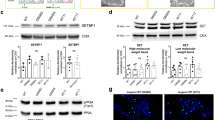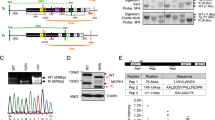Abstract
Nijmegen breakage syndrome (NBS), ataxia telangiectasia and ataxia telangiectasia–like disorder (ATLD) show overlapping phenotypes such as growth retardation, microcephaly, cerebellar developmental defects and ataxia. However, the molecular pathogenesis of these neurological defects remains elusive. Here we show that inactivation of the Nbn gene (also known as Nbs1) in mouse neural tissues results in a combination of the neurological anomalies characteristic of NBS, ataxia telangiectasia and ATLD, including microcephaly, growth retardation, cerebellar defects and ataxia. Loss of Nbn causes proliferation arrest of granule cell progenitors and apoptosis of postmitotic neurons in the cerebellum. Furthermore, Nbn-deficient neuroprogenitors show proliferation defects (but not increased apoptosis) and contain more chromosomal breaks, which are accompanied by ataxia telangiectasia mutated protein (ATM)-mediated p53 activation. Notably, depletion of p53 substantially rescues the neurological defects of Nbn mutant mice. This study gives insight into the physiological function of NBS1 (the Nbn gene product) and the function of the DNA damage response in the neurological anomalies of NBS, ataxia telangiectasia and ATLD.
This is a preview of subscription content, access via your institution
Access options
Subscribe to this journal
Receive 12 print issues and online access
$209.00 per year
only $17.42 per issue
Buy this article
- Purchase on Springer Link
- Instant access to full article PDF
Prices may be subject to local taxes which are calculated during checkout





Similar content being viewed by others
Change history
17 April 2005
replaced the incorrect figure with the correct image
Notes
NOTE: In the version of this article initially published online, labels in Fig. 5a and b were incorrect. This mistake has been corrected for the HTML and print versions of the article.
References
van der Burgt, I., Chrzanowska, K.H., Smeets, D. & Weemaes, C. Nijmegen breakage syndrome. J. Med. Genet. 33, 153–156 (1996).
Stewart, G.S. et al. The DNA double-strand break repair gene hMRE11 is mutated in individuals with an ataxia-telangiectasia-like disorder. Cell 99, 577–587 (1999).
Tauchi, H., Matsuura, S., Kobayashi, J., Sakamoto, S. & Komatsu, K. Nijmegen breakage syndrome gene, NBS1, and molecular links to factors for genome stability. Oncogene 21, 8967–8980 (2002).
Shiloh, Y. ATM and related protein kinases: safeguarding genome integrity. Nat. Rev. Cancer. 3, 155–168 (2003).
Chun, H.H. & Gatti, R.A. Ataxia-telangiectasia, an evolving phenotype. DNA. Repair. (Amst). 3, 1187–1196 (2004).
D'Amours, D. & Jackson, S.P. The Mre11 complex: at the crossroads of dna repair and checkpoint signalling. Nat. Rev. Mol. Cell. Biol. 3, 317–327 (2002).
Dumon-Jones, V. et al. Nbn heterozygosity renders mice susceptible to tumor formation and ionizing radiation-induced tumorigenesis. Cancer. Res. 63, 7263–7269 (2003).
Zhu, J., Petersen, S., Tessarollo, L. & Nussenzweig, A. Targeted disruption of the Nijmegen breakage syndrome gene NBS1 leads to early embryonic lethality in mice. Curr. Biol. 11, 105–109 (2001).
Xiao, Y. & Weaver, D.T. Conditional gene targeted deletion by Cre recombinase demonstrates the requirement for the double-strand break repair Mre11 protein in murine embryonic stem cells. Nucleic. Acids. Res. 25, 2985–2991 (1997).
Kang, J., Bronson, R.T. & Xu, Y. Targeted disruption of NBS1 reveals its roles in mouse development and DNA repair. Embo. J. 21, 1447–1455 (2002).
Williams, B.R. et al. A murine model of Nijmegen breakage syndrome. Curr. Biol. 12, 648–653 (2002).
Theunissen, J.W. et al. Checkpoint failure and chromosomal instability without lymphomagenesis in Mre11(ATLD1/ATLD1) mice. Mol. Cell. 12, 1511–1523 (2003).
McConnell, M.J. et al. Failed clearance of aneuploid embryonic neural progenitor cells leads to excess aneuploidy in the Atm-deficient but not the Trp53-deficient adult cerebral cortex. J. Neurosci. 24, 8090–8096 (2004).
Allen, D.M. et al. Ataxia telangiectasia mutated is essential during adult neurogenesis. Genes. Dev. 15, 554–566 (2001).
Barlow, C. et al. Atm-deficient mice: a paradigm of ataxia telangiectasia. Cell 86, 159–171 (1996).
Xu, Y. et al. Targeted disruption of ATM leads to growth retardation, chromosomal fragmentation during meiosis, immune defects, and thymic lymphoma. Genes. Dev. 10, 2411–2422 (1996).
Borghesani, P.R. et al. Abnormal development of Purkinje cells and lymphocytes in Atm mutant mice. Proc. Natl. Acad. Sci. USA. 97, 3336–3341 (2000).
Betz, U.A., Vosshenrich, C.A., Rajewsky, K. & Muller, W. Bypass of lethality with mosaic mice generated by Cre-loxP-mediated recombination. Curr. Biol. 6, 1307–1316 (1996).
Fei, P. & El-Deiry, W.S. P53 and radiation responses. Oncogene 22, 5774–5783 (2003).
Slee, E.A., O'Connor, D.J. & Lu, X. To die or not to die: how does p53 decide? Oncogene 23, 2809–2818 (2004).
Groszer, M. et al. Negative regulation of neural stem/progenitor cell proliferation by the Pten tumor suppressor gene in vivo. Science 294, 2186–2189 (2001).
Shiloh, Y. & Kastan, M.B. ATM: genome stability, neuronal development, and cancer cross paths. Adv. Cancer. Res. 83, 209–254 (2001).
Maser, R.S., Zinkel, R. & Petrini, J.H. An alternative mode of translation permits production of a variant NBS1 protein from the common Nijmegen breakage syndrome allele. Nat. Genet. 27, 417–421 (2001).
Demuth, I. et al. An inducible null mutant murine model of Nijmegen breakage syndrome proves the essential function of NBS1 in chromosomal stability and cell viability. Hum. Mol. Genet. 13, 2385–2397 (2004).
Goldowitz, D. & Hamre, K. The cells and molecules that make a cerebellum. Trends. Neurosci. 21, 375–382 (1998).
Lee, Y. & McKinnon, P.J. ATM dependent apoptosis in the nervous system. Apoptosis 5, 523–529 (2000).
Abner, C.W. & McKinnon, P.J. The DNA double-strand break response in the nervous system. DNA. Repair. (Amst). 3, 1141–1147 (2004).
Xu, X. et al. Genetic interactions between tumor suppressors Brca1 and p53 in apoptosis, cell cycle and tumorigenesis. Nat. Genet. 28, 266–271 (2001).
Gao, Y. et al. A critical role for DNA end-joining proteins in both lymphogenesis and neurogenesis. Cell 95, 891–902 (1998).
Gao, Y. et al. Interplay of p53 and DNA-repair protein XRCC4 in tumorigenesis, genomic stability and development. Nature 404, 897–900 (2000).
Frank, K.M. et al. Late embryonic lethality and impaired V(D)J recombination in mice lacking DNA ligase IV. Nature 396, 173–177 (1998).
Frank, K.M. et al. DNA ligase IV deficiency in mice leads to defective neurogenesis and embryonic lethality via the p53 pathway. Mol. Cell. 5, 993–1002 (2000).
Lakin, N.D. & Jackson, S.P. Regulation of p53 in response to DNA damage. Oncogene 18, 7644–7655 (1999).
Lee, J.H. & Paull, T.T. Direct activation of the ATM protein kinase by the Mre11/Rad50/Nbs1 complex. Science 304, 93–96 (2004).
Stracker, T.H., Theunissen, J.W., Morales, M. & Petrini, J.H. The Mre11 complex and the metabolism of chromosome breaks: the importance of communicating and holding things together. DNA. Repair. (Amst). 3, 845–854 (2004).
Lee, Y. & McKinnon, P.J. DNA ligase IV suppresses medulloblastoma formation. Cancer. Res. 62, 6395–6399 (2002).
Tong, W.M. et al. Null mutation of DNA strand break-binding molecule poly(ADP-ribose) polymerase causes medulloblastomas in p53(−/−) mice. Am. J. Pathol. 162, 343–352 (2003).
Herson, P.S. et al. A mouse model of episodic ataxia type-1. Nat. Neurosci. 6, 378–383 (2003).
Acknowledgements
We thank D. Galendo for her excellent assistance in the maintenance of the animal colonies, and C. Carreira, G. Hildebrand, N. Lyandrat and S. Roche for their excellent technical assistance. We also thank Y. Shiloh, M. Tommasino and E. F. Wagner for critical reading of the manuscript. We are grateful to J. Cheney and F. Corry for editing the manuscript. P.-O. Frappart is a recipient of a fellowship from the Comité Départmental de la Ligue Nationale contre le Cancer de Haute-Savoie (2000–2002), the Association de la Recherche pour le Cancer (ARC) (2002–2003) and the Ligue Nationale contre le Cancer (2004). This work was supported by the Deutsche Forschungsgemeinschaft (SFB577).
Author information
Authors and Affiliations
Corresponding author
Ethics declarations
Competing interests
The authors declare no competing financial interests.
Supplementary information
Supplementary Fig. 1
Phenotypic and molecular analysis of Nbn-CNS-del mice. (PDF 166 kb)
Rights and permissions
About this article
Cite this article
Frappart, PO., Tong, WM., Demuth, I. et al. An essential function for NBS1 in the prevention of ataxia and cerebellar defects. Nat Med 11, 538–544 (2005). https://doi.org/10.1038/nm1228
Received:
Accepted:
Published:
Issue Date:
DOI: https://doi.org/10.1038/nm1228
This article is cited by
-
Molecular and functional heterogeneity in dorsal and ventral oligodendrocyte progenitor cells of the mouse forebrain in response to DNA damage
Nature Communications (2022)
-
Chromosome instability syndromes
Nature Reviews Disease Primers (2019)
-
MRE11 inhibition highlights a replication stress-dependent vulnerability of MYCN-driven tumors
Cell Death & Disease (2018)
-
C9orf72 expansion disrupts ATM-mediated chromosomal break repair
Nature Neuroscience (2017)
-
Rint1 inactivation triggers genomic instability, ER stress and autophagy inhibition in the brain
Cell Death & Differentiation (2016)



